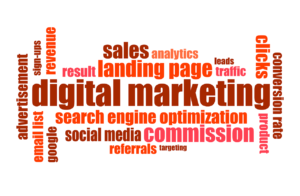
In today’s digital age, having an effective digital marketing plan is crucial for businesses to reach and engage their target audience. A well-crafted plan helps businesses establish a strong online presence, drive website traffic, generate leads, and ultimately achieve their marketing goals. In this article, we will outline the steps involved in creating an effective digital marketing plan.

Step 1: Set Clear Goals and Objectives
The first step in developing a digital marketing plan is to set clear and measurable goals. Determine what you want to achieve with your digital marketing efforts. Is it to increase brand awareness, drive website traffic, generate leads, boost conversions, or enhance customer engagement? Set specific and realistic goals that align with your overall business objectives.
Step 2: Understand Your Target Audience
To effectively reach your audience, you need a deep understanding of who they are. Conduct market research to identify your target audience’s demographics, preferences, behaviors, and pain points. Develop buyer personas that represent your ideal customers, including their age, gender, location, interests, and online behavior. This information will guide your digital marketing strategies and help you tailor your messaging and content to resonate with your audience.
Step 3: Choose the Right Digital Marketing Channels
There are numerous digital marketing channels available, and selecting the right ones for your business is crucial. Consider your target audience’s preferences and behavior to determine which channels will best reach and engage them. Common digital marketing channels include search engine optimization (SEO), social media marketing, content marketing, email marketing, paid advertising (PPC), influencer marketing, and mobile marketing. Choose channels that align with your goals, audience, and budget.
Step 4: Develop a Content Strategy
Content is the backbone of digital marketing. Create a content strategy that aligns with your goals and target audience. Determine the types of content that will resonate with your audience, such as blog posts, videos, infographics, or podcasts. Plan your content calendar, including topics, formats, and distribution channels. Ensure your content provides value, solves problems, and addresses your audience’s needs. Incorporate relevant keywords and optimize your content for search engines.
Step 5: Build a Strong Online Presence
Establishing a strong online presence is vital for digital marketing success. Ensure your website is user-friendly, visually appealing, and optimized for search engines. Implement SEO strategies to improve your website’s visibility in search engine results. Develop a consistent brand voice and messaging across all digital channels to enhance brand recognition and trust. Engage with your audience through social media platforms, respond to comments and messages promptly, and build a community around your brand.
Step 6: Implement Effective Lead Generation Strategies
Lead generation is a crucial aspect of digital marketing. Implement strategies to capture and nurture leads. Create compelling lead magnets, such as e-books, webinars, or free trials, to entice visitors to provide their contact information. Utilize landing pages, forms, and call-to-action buttons to capture leads. Implement email marketing campaigns to nurture leads and guide them through the sales funnel. Continuously optimize your lead generation strategies based on data and feedback.
Step 7: Monitor, Analyze, and Optimize
Regularly monitor and analyze the performance of your digital marketing campaigns. Use analytics tools, such as Google Analytics, to track important metrics like website traffic, engagement, conversion rates, and ROI. Analyze the data to gain insights into what’s working and what needs improvement. Make data-driven decisions and optimize your strategies accordingly. Test different variations of your campaigns, landing pages, and content to improve results over time.
Step 8: Stay Updated and Evolve
The digital marketing landscape is ever-evolving, with new technologies and trends emerging regularly. Stay updated with industry news, algorithm changes, and new marketing tools. Continuously educate yourself and your team on the latest digital marketing practices. Adapt your strategies to reflect the changing needs and preferences of your audience. Embrace innovation and explore new opportunities to stay ahead of the competition.


















